Science
The Trance
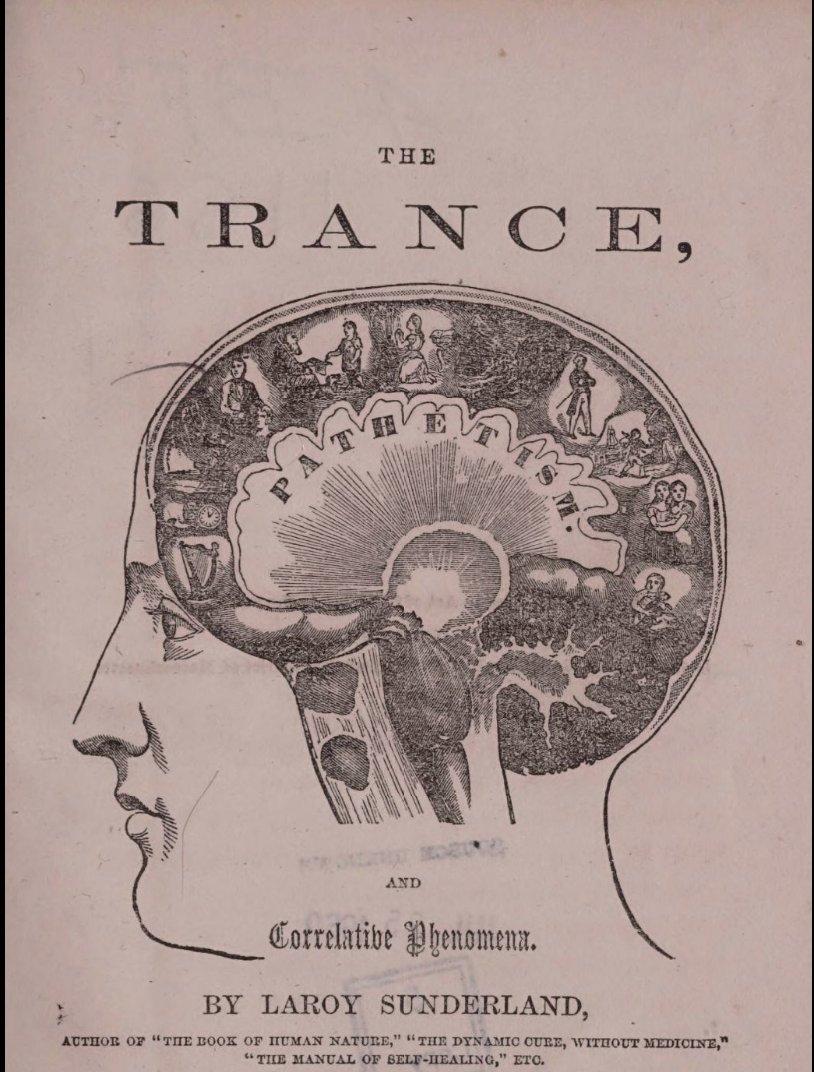
Everything you need to know about religious trances.
Posted By: Paul - Fri Nov 13, 2020 -
Comments (0)
Category: Religion, Science, Supernatural, Occult, Paranormal, Books, Nineteenth Century
Hot Chocolate Effect
As defined by Wikipedia:via TYWKIWDBI
Posted By: Alex - Thu Nov 12, 2020 -
Comments (3)
Category: Noises and Other Public Disturbances of the Peace, Science
Mokapzu Park
Mokapzu Park from Art&Graft on Vimeo.
Posted By: Paul - Tue Nov 10, 2020 -
Comments (1)
Category: Animals, Armageddon and Apocalypses, Humor, Science
The Rule of 87
This "Rule of 87" may have been true in the mid-twentieth century, but I'm guessing that the rise of fertility drugs played havoc with it.
I'll also note that the Minnesota Twins won the 1987 World Series. Coincidence?
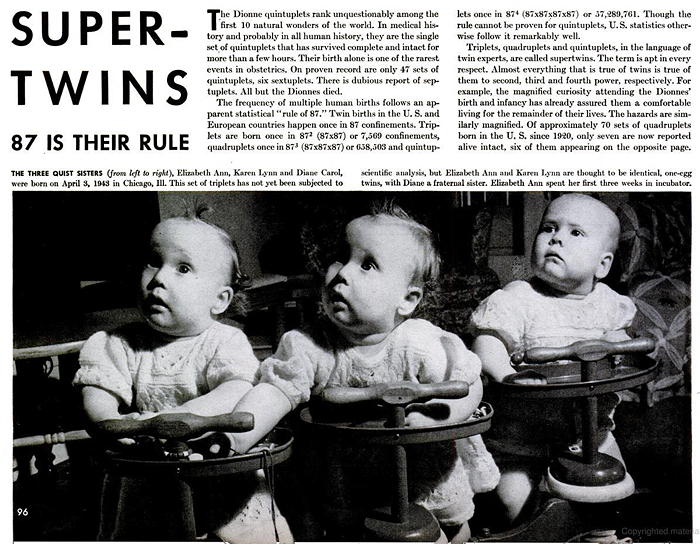
Posted By: Alex - Fri Oct 02, 2020 -
Comments (3)
Category: Babies, Science
The Techno-Chemical Receipt Book

This is one of those volumes you pack away for when civilization collapses, as it give the formulas for making from scratch glass, nitroglycerin, glue, and a thousand other handy things.
Read it here.
Posted By: Paul - Sun Sep 13, 2020 -
Comments (2)
Category: Science, Technology, Books, Nineteenth Century
The science of removing bugs from windshields
When you clean bugs off your car's windshield, think of Detroit researcher Clark Wells who spent his career figuring out how best to do this.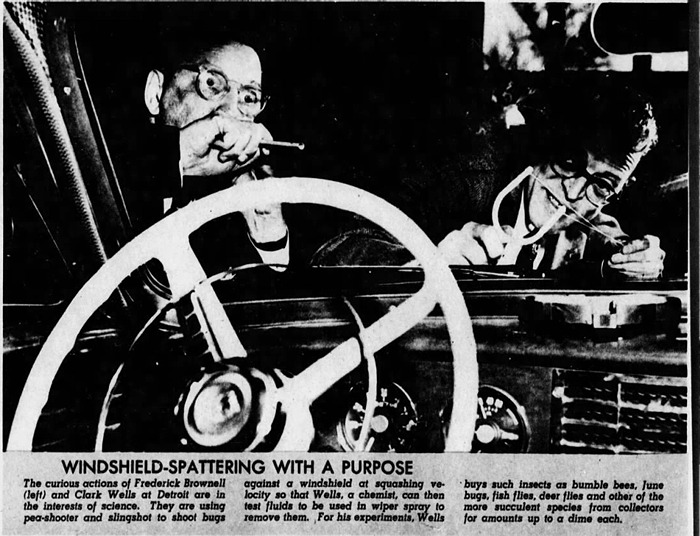
St. Louis Post-Dispatch - Mar 22, 1953
The curious actions of Frederick Brownell (left) and Clark Wells at Detroit are in the interests of science. They are using pea-shooter and slingshot to shoot bugs against a windshield at squashing velocity so that Wells, a chemist, can then test fluids to be used in wiper spray to remove them. For his experiments, Wells buys such insects as bumble bees, June bugs, fish flies, deer flies and other of the more succulent species from collectors for amounts up to a dime each.

Huntsville Times - June 20, 1954
Posted By: Alex - Sat Aug 08, 2020 -
Comments (2)
Category: Insects and Spiders, Science, 1950s, Cars
Falling Cats
The physics of falling cats. Narrated by Australian physicist Karl Kruszelnicki.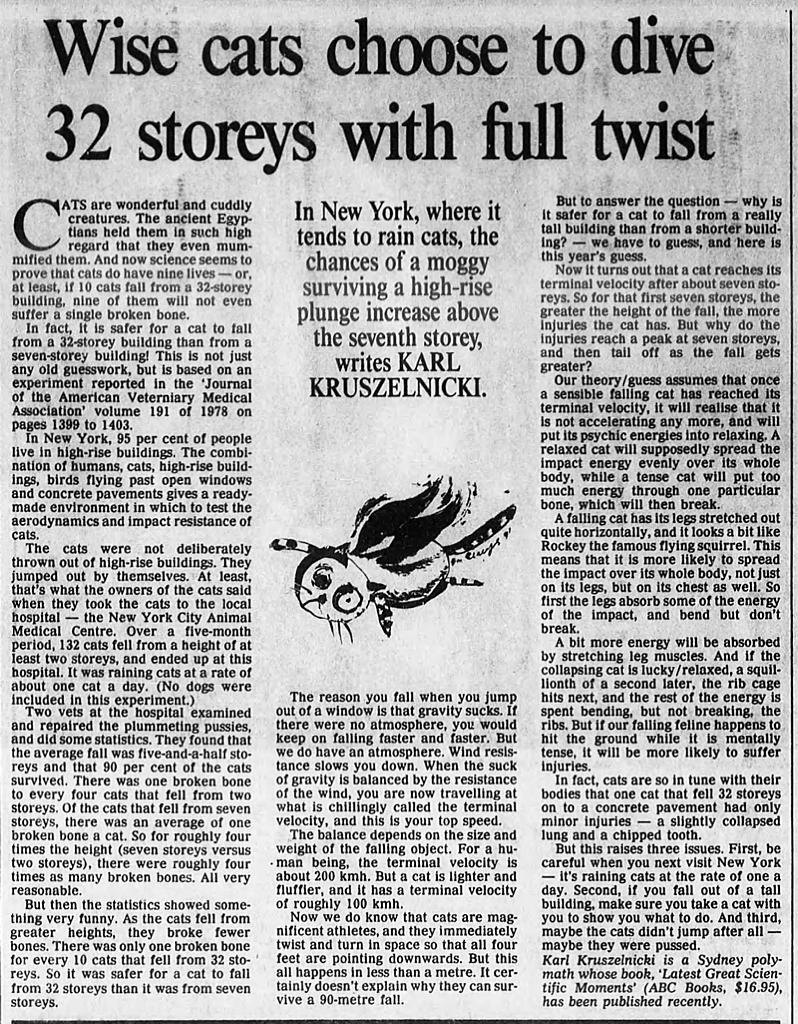
The Age (Melbourne, Australia) - Sep 4, 1991
Posted By: Alex - Sat Jun 27, 2020 -
Comments (3)
Category: Science, Cartoons, Cats
The drift pattern of Nike shoes
In May 1990, five shipping containers holding approximately 80,000 pairs of Nike shoes fell off a freighter during a storm in the North Pacific. About 200 days later, some of these shoes began to wash up on beaches from Canada down to Oregon.But as beachcombers collected and compared the shoes, they noticed something odd. On beaches up north, in Canada and Washington, almost all the shoes were right-footed; whereas further south in Oregon, most of the shoes were left-footed.
Skye Moody explains why this was so in her book Washed Up: The Curious Journeys of Flotsam and Jetsam:
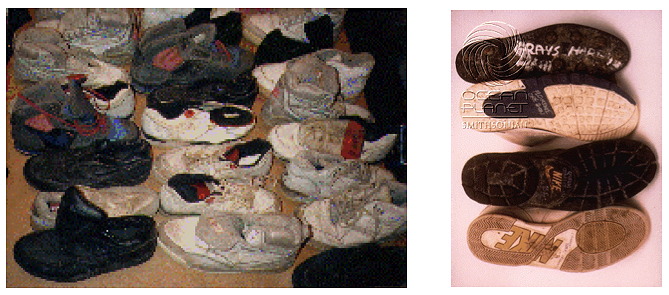
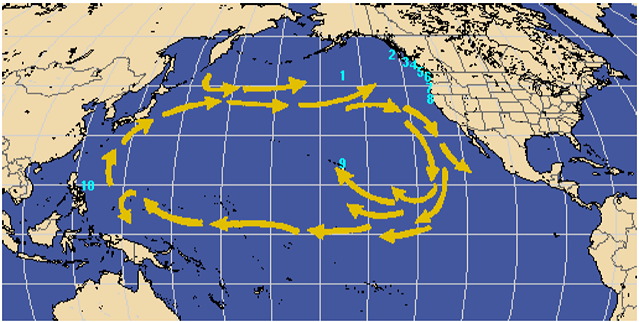
Drift pattern of Nike shoes
image source: The Nike Shoe Investigation
Oceanographer Curtis Ebbesmeyer co-authored an academic paper about the 1990 shoe spill ("Shoe spill in the North Pacific" -- unfortunately behind a paywall). It also inspired him to start studying other ocean flotsam, such as rubber duckies, as a way to gain info about currents. He calls this study 'flotsametrics'. He also occasionally puts out a Beachcombers' Alert Newsletter.
Posted By: Alex - Tue Jun 16, 2020 -
Comments (0)
Category: Science, Shoes, 1990s
Staring Hitchhikers
Will hitchhikers get more rides if they stare at oncoming drivers or if they look away? A 1974 study published in the Journal of Applied Social Psychology attempted to answer this question:In the stare conditions, E stared at the driver of the target vehicle and attempted to fixate on the driver's gaze and maintain this gaze as long as possible until the driver either stopped his vehicle or drove on. In the comparison conditions, E looked anywhere else but at the driver. Thus, on some trials E looked in the general direction of the car; on other trials E looked at his feet, the road, the sky, etc. Es were specifically instructed to neither smile nor frown, and to maintain a casual (neither rigid nor slouching) body postural orientation while soliciting rides.
The two hitchhikers were described as, "both 20 years of age and both dressed in bluejeans and dark coats. The male had short, curly blond hair, and the female, straight, shoulder length blond hair. Both could be described as neat, collegiate, attractive in physical appearance, and of an appropriate age to be hitchhiking."

A hitchhiker in Luxembourg - Aug 1977 (source: wiktionary.org)
(not one of the hitchhikers in the study)
Staring is often interpreted as a threat. So the researchers anticipated that staring at oncoming drivers might result in fewer rides. But the opposite turned out to be true. Which is a useful tip to know if you ever need to hitchhike. But what really helped get a lot of rides was being a single female. From the study:
Contrary to popular belief and hitchhiking folklore , it was no easier for a male-female couple to hitch a ride than a single male, and a mixed sex couple was less successful at soliciting rides than a single female hitchhiker. Although the generality of this conclusion is limited by the fact that it is based upon results obtained by one male and one female E, it is probably the case that couples are less successful hitching rides because of space limitations in the cars they approach. That is, it is more likely that the driver will have room for one additional passenger than that he will have room for two or more additional passengers in his car.
Incidentally, the experimenters never actually ever got in a car with anyone: "After a motorist stopped to pick up one of the hitchhikers, he was politely thanked and given a printed description of the nature of the experiment. No driver expressed any discomfort when he learned that the hitchhiker did not actually want a ride."
Posted By: Alex - Mon May 04, 2020 -
Comments (5)
Category: Science, Experiments, Psychology, 1970s, Cars
Do Beavers Rule on Mars?
In the May 1930 issue of Popular Science magazine, Thomas Elway advanced the unusual hypothesis that Mars was inhabited by a race of beavers. His idea was subsequently reported in many newspapers.As far as I can tell, Elway wasn't actually a scientist. He was a journalist. So perhaps one shouldn't attach too much weight to his opinion. Still, he gets points for creativity.
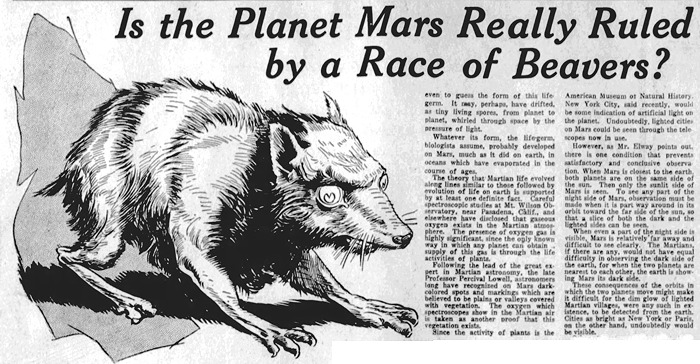
Semi-Weekly Spokesman Review - Oct 12, 1930
Elway's argument was based on the assumption (widespread at the time) that there was plant life on Mars. Therefore, animal life was also considered possible. His reasoning then proceeded as follows:
This lack of manlike life is precisely what a biologist would expect. Man and man's active mind are believed to be products of the Great Ice Age, for that time of stress and competition on earth is what is supposed to have turned mankind's anthropoid ancestors into men. The period of ice and cold over wide areas of the earth was caused, at least in part, by the elevation of continents and mountain ranges. On Mars, no mountain ranges exist, and it probably never had an Ice Age.
It is on these hypotheses that science bases its assumption that there is no human intelligence on Mars, and that animal life on the planet is still in the age of instinct. The thing to expect on Mars, then, is a fish life much like that on earth, the emergence of this fish life onto the land, and the evolution of these Martian land-fishes into retilelike creatures. Finally, animals resembling the earth's present rodents like rats, squirrels, and beavers would make their appearance.
The chief reason to expect this final change of Martian retiles into primitive mammals lies in the fact that on earth this evolution seems to have been forced by changeable weather. And Mars now possesses seasonal changes like those on earth.
Pure biological reasoning makes it probable, therefore, that the evolution of warm-blooded animals may have occurred on Mars much as it did here. There seems no reason to believe that Martian life has gone farther than that. Mars is a relatively changeless planet. Biologists suppose that the rise and fall of mountains, the increase and decrease in volcanic activity, and the ebb and flow of climate forced life on earth along its upward path. Martian life of recent ages seems to have lacked these natural incentives to better things.
Now, there is one creature on earth for the development of whose counterpart the supposed Martian conditions would be ideal. That animal is the beaver. It is either land-living or water-living. It has a fur coat to protect it from the 100 degrees below zero of the Martian night.
The Martian beavers, of course, would not be exactly like those on earth. That they would be furred and water-loving is probable. Their eyes might be larger than those of the earthly beaver because the sunlight is not so strong, and their bodies might be larger because of lesser Martian gravity. Competent digging tools certainly would be provided on their claws. The chests of these Martian beavers would be larger and their breathing far more active, as there is less oxygen in the air on Mars.
Such beaver-Martians are nothing more than pure speculation, but the idea is based upon the known facts that there is plenty of water on Mars; that vegetation almost certainly exists there; that Mars has no mountains and could scarcely have had an Ice Age; and that evidences of Martian life are not accompanied by signs of intelligence.
Herds of beaver-creatures are at least a more reasonable idea than the familiar fictional one of manlike Martians digging artificial water channels with vast machines or the still more fantastic notion of octopuslike Martians sufficiently intelligent to plan the conquest of the earth.
Posted By: Alex - Thu Apr 02, 2020 -
Comments (5)
Category: Aliens, Animals, Science, 1930s

| Who We Are |
|---|
| Alex Boese Alex is the creator and curator of the Museum of Hoaxes. He's also the author of various weird, non-fiction, science-themed books such as Elephants on Acid and Psychedelic Apes. Paul Di Filippo Paul has been paid to put weird ideas into fictional form for over thirty years, in his career as a noted science fiction writer. He has recently begun blogging on many curious topics with three fellow writers at The Inferior 4+1. Contact Us |




